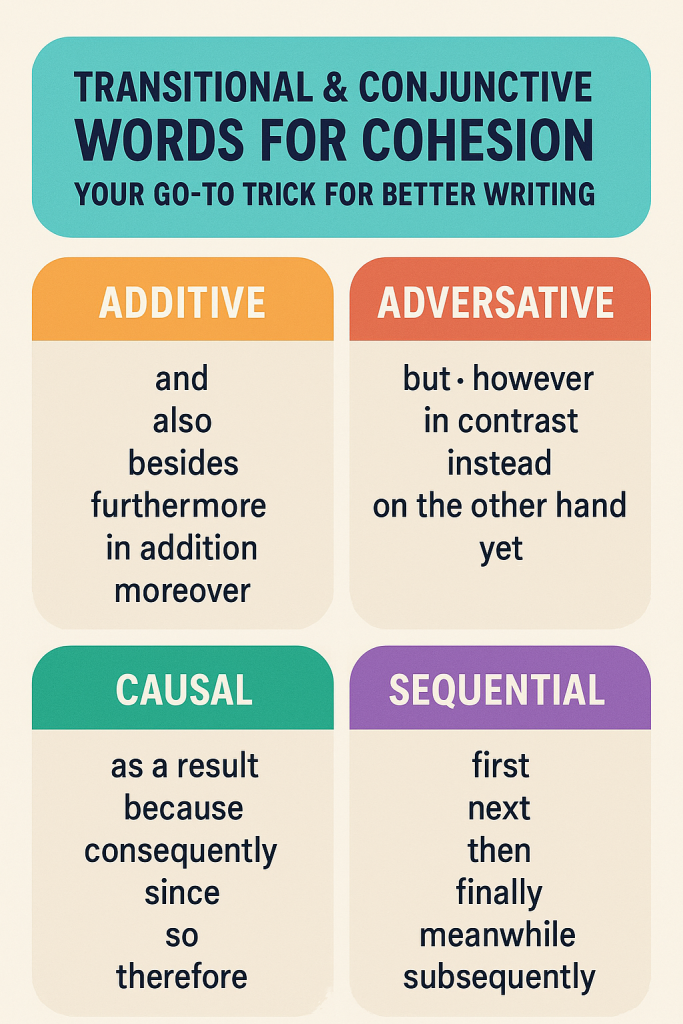Picture this: I’m slogging through a friend’s blog post about hiking, and it’s like reading a grocery list. “I climbed a hill. It was steep. I saw a deer. I went home.” Yawn! What’s missing? Those little words—however, for example, on top of that—that make writing feel like a story, not a robot’s diary. These are transitional words for cohesion, and they’re my secret weapon for turning clunky text into something smooth and readable. I’ve been blogging for years, and trust me, these words are a lifesaver whether I’m writing posts, school papers, or even emails to my boss. Let’s dive into what they are, why they’re awesome, and how you can use them to make your writing shine.

Okay, What Are These Magic Words?
So, transitional words (and their buddies, conjunctive words) are like the glue that holds your sentences together. They’re the “turn left here” signs that keep your reader from getting lost. Without them, your writing can feel like a bad road trip—no directions, just confusion. If you’re curious about other grammar tricks, check out our guide on conjunctions.
Here’s the breakdown of the main types, with examples I use all the time:
- Adding stuff (like also or plus): These pile on more info. I once wrote, “I love coffee. Plus, it keeps me awake for late-night writing.”
- Showing contrast (like but or on the other hand): These flip the script. Example: “I planned a beach day, but it rained cats and dogs.”
- Explaining why (like so or because): These connect cause and effect. Example: “I skipped breakfast, so I was starving by noon.”
- Keeping order (like first or finally): These organize your thoughts. Example: “First, pick a topic. Next, start drafting.”
These aren’t just random words—they’re tools to make your writing flow like a good playlist. Want to polish other grammar skills? Our punctuation guide pairs perfectly with this. But you gotta use transitions wisely, or it’s like overplaying your favorite song. Annoying.
Why Cohesion Is Your Writing’s Best Friend
Ever read something that felt like it was written by a toddler with a keyboard? No flow, no logic, just chaos. That’s what happens without writing cohesion. Transitions are like the friend who says, “Hey, follow me!” so your reader doesn’t wander off. They’re a big deal in all kinds of writing, and here’s why:
- Blogging: Online folks skim like nobody’s business. Transitions like for instance keep them hooked. Like, a travel blogger might say, “Rome’s amazing. For instance, the Colosseum blew my mind.”
- School papers: Professors are picky about clarity. Words like therefore or however make your essay sound smart. Example: “The data was shaky. However, it sparked some cool debates.”
- Work emails: Nobody wants a confusing email. Instead of “I’m busy. I’ll send the report later,” try, “I’m swamped, so I’ll send the report later.” Way clearer, right? For more email tips, see our post on comma rules for emails.
I learned this the hard way. My first blog post was a total mess—readers bounced faster than a bad date. Adding transitions saved me. They’re like the WD-40 for your writing: everything just glides. The University of Wisconsin’s writing guide has a great take on this if you want more details.
Five Tricks to Use Transition Words Like a Boss
Alright, let’s get to the fun part—how to actually use transition words examples without sounding like a textbook. Here are five tricks I’ve picked up from my own writing flops and wins. Oh, and if you’re worried about mixing up words, our guide on commonly confused words is a lifesaver.
1. Match the Vibe
Pick a transition that fits what you’re saying. Contrasting? Use on the other hand. Adding? Try also. Example: “I wanted to finish this post. On the other hand, Netflix was calling my name.”
2. Chill with the Overuse
Too many transitions make you sound like a try-hard. I once stuffed therefore into every sentence—ugh, cringe. Keep it simple. Example: “The meeting ran late. As a result, I missed my train.”
3. Switch It Up
Repeating and or but gets old fast. Toss in furthermore or by the way for variety. Example: “This recipe’s easy. By the way, it’s cheap too.”
4. Link Those Paragraphs
Big ideas need big connections. Start paragraphs with meanwhile or to wrap up to tie them to the last one. Example: “My blog traffic tanked. Meanwhile, my competitor’s site was booming.”
5. Try It Yourself
Grab an old draft and play around. I did this with a college essay: “I studied history. It was boring. I passed.” Rewrote it: “I studied history. Sure, it was boring, but I passed.” Night and day difference! For practice, try our paraphrasing tool to rephrase your drafts.
Still curious? Purdue OWL’s transition guide has a ton of examples. It’s my go-to when I’m stuck.
Wrapping It All Up
Look, transitional and conjunctive words are like the spices in your favorite dish—small but mighty. They make your writing flow, keep readers glued, and honestly, make you sound like you know what you’re doing. Whether you’re blogging about your dog or writing a report for work, these words are your besties. Don’t overdo it, mix them up, and practice a bit. Next time you’re drafting, toss in a however or for example and watch your writing go from meh to wow. So, go on—give it a whirl. Your readers will love you for it.
Need more writing hacks? Check out our business email tips or use our grammar checker to polish your work.
